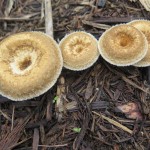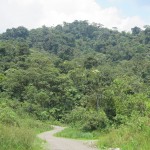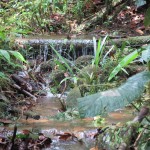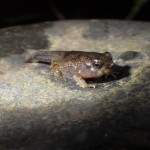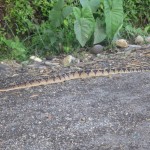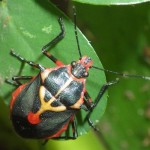Hello, again, from not-too-far-from (well, about 45 kilometres/30 miles) the newly erupting Volcán Tungurahua which has been throwing out a column of ash, flames and some rocks to a height of around three kilometres in the last few days. The volcano (5.023 metres -16.480 feet in height) has been erupting periodically since 1999, although in the last 1300 years major phases of volcanic activity have taken place every 80-100 years – in 1773, 1886, and 1916-18, hmmmm…… Anyway, at the moment the wind is taking the ash north-west so it is not noticeably reaching the land.
On the land, sand and stones continue to be moved up to be used in the construction of the toilet/shower subject to weather – there has been a fair amount of heavy rain which has stopped play from time to time. Wilson, an old friend and sometime volunteer, appeared with a couple of friends from Mera to help out, as well, which was great.
Another task to be undertaken soon is the clearance of some large fallen trees which are hanging dangerously over the waterfall. We haven’t yet quite determined how this will be done!
On a recent walk out, (with a single car passing in the whole sixteen kilometres!) one of the local, small groups of Tamarin monkeys was spotted fleetingly. They appeared darker than those usually seen, although that may have been the distance (or the sunglasses!). Another group was seen around the land last week.
The other night, on a short trip up to Prawn World, whilst observing some of the plants at the side of the path (everything appears so different at night, and there are always different species to spot) a rather large Bushmaster snake was very nearly stepped upon! We are fairly confident that it is a different one to the one released about a month ago– it appeared to be smaller, although not by much – a beautiful animal. It had disappeared a short time later……….
Two female Umbrella Birds continue to be seen around the land, as well as several owl species and a large, healthy-looking coati was also seen recently in the early evening.
Just a few days ago, what at first appeared to be a sizeable bee, was spotted on the land. However, that is not what it was – it was in fact a tiny hummingbird – estimated to be not much larger than two centimetres in height, or a total length of around three-plus centimetres. It was not properly identified as it wasn’t seen for long enough to spot all of its details, unfortunately. A similar bird has been spotted before, a couple of years ago, and Laurence also saw this or a similar bird a couple of weeks ago not far away. In Ecuador, a relatively small country, there are about 130 species of hummingbirds. Hummingbirds digest their food rapidly due to their small size and high metabolism and they spend an average of 10–15% of their time feeding and 75–80% sitting and digesting. Hummingbirds are specialized nectivores and are tied to the specific flowers upon which they feed. Some species, especially those with unusual bill shapes are co-evolved with a small number of flower species. Many plants pollinated by hummingbirds produce flowers in shades of red, orange, and bright pink.
As our older tree nursery is kind of falling apart – the wooden uprights being well-past their best, the cover was removed and a new nursery is being put up on a temporary basis, at the side of the quarantine/clinic. Various endemic fruit trees are to be grown (we have the seeds), including some more palms, which will provide an appropriate habitat on the land and around to attract and support more local wildlife as well as providing potential foods for any animals we rescue /release in the future.
Thanks are due to Peter Archer for some of the photos this time round, and also to Laurence Duvauchelle for her great assistance to the Fundación as Secretary to the Management Committee (Equipo directive) from which she recently resigned.

